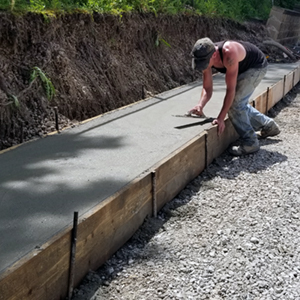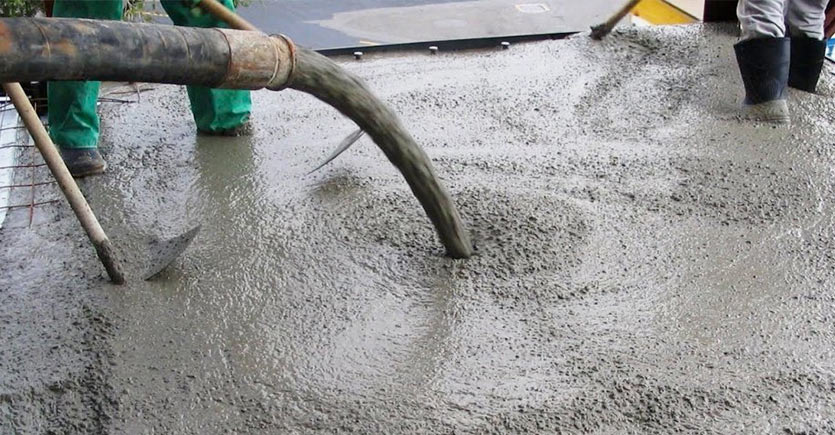Achieve Structural Quality: Exploring the Advantages and Diverse Kind Of Concrete Slabs for Your Building

Benefits of Concrete Pieces
Concrete slabs use a wide variety of benefits for homeowner seeking toughness and long life in their construction jobs. Among the vital advantages of using concrete slabs is their outstanding toughness and resistance to hefty lots, making them ideal for supporting frameworks like patio areas, driveways, and structures. In addition, concrete slabs call for minimal upkeep compared to other construction products, conserving building owners both time and money over time.
Another benefit of concrete slabs is their convenience in style and customization (concrete contractors brooksville). Homeowner can select from different surfaces, shades, and patterns to attain the desired aesthetic for their task. This adaptability enables for seamless combination with various building designs, enhancing the general charm of the property
Furthermore, concrete slabs are understood for their thermal performance, aiding to control indoor temperatures and minimize power intake. This can cause cost savings on cooling and heating bills for homeowner. Generally, the advantages of concrete slabs make them a practical and trustworthy choice for construction tasks that require toughness, durability, and stamina.
Usual Kinds Of Concrete Slabs
Among the numerous building and construction materials available, different kinds of concrete slabs supply unique characteristics and applications based upon their design and structure. One common kind is the traditional concrete piece, which is a cost-efficient and simple option suitable for numerous property and industrial tasks. An additional preferred selection is the post-tensioned concrete slab, recognized for its raised strength and capacity to span longer ranges without calling for additional assistance. For tasks where insulation is a concern, insulated concrete slabs supply power efficiency by decreasing warm loss and minimizing thermal connecting. Ribbed or waffle slabs are favored for their lightweight nature and high load-bearing capability, making them optimal for bigger frameworks such as vehicle parking garages or industrial buildings. Additionally, flat plate slabs use a straightforward and functional solution for structures with restricted floor-to-floor elevations. By understanding the attributes of these common concrete piece types, homeowner and contractors can make enlightened choices to meet their specific construction needs.
Support Options for Concrete Pieces
When taking into consideration the building of concrete pieces, recognizing the various support options offered is important for making sure architectural honesty and longevity. Reinforcement in concrete slabs aids distribute loads, stop cracking, and enhance sturdiness. One common technique of reinforcement is with the use of steel rebar, which is positioned within the concrete to supply tensile toughness and withstand splitting under heavy loads. One more option is using wire mesh, usually constructed from welded wire fabric (WWF), which assists control fracturing and provides added support to the concrete piece.
Fiber support has likewise gotten popularity in recent times. Fibers such as steel, glass, or synthetic products are included to the concrete mix to improve its toughness and minimize the risk of breaking. Fiber reinforcement is particularly beneficial in regulating plastic shrinking fracturing and boosting impact resistance in concrete pieces.
Eventually, the option of support choice for concrete pieces depends upon variables such as tons demands, environmental conditions, and spending plan restraints. Consulting with a structural designer can assist identify the most suitable support method for a specific project, making certain a durable and durable concrete piece.
Variables Influencing Concrete Slab Option
A number of variables play an essential duty in establishing one of the most ideal concrete slab for a construction task. The very first aspect to take into consideration is the designated use of the framework. Heavy-duty industrial centers may need thicker and much more enhanced pieces compared to residential buildings or industrial areas. The soil problems of the building and construction site additionally play a substantial role in selecting the appropriate kind site here of concrete piece. Websites with inadequate soil high quality might require unique considerations such as deeper foundations or using post-tensioned slabs to stop clearing up and fracturing. Additionally, the anticipated loads on the slab, whether fixed or vibrant, require to be assessed to ensure that the picked slab can withstand the anticipated pressures in time. Climate and ecological aspects, such as freeze-thaw cycles or direct exposure to chemicals, will also impact the choice of the concrete mix layout and surface therapies to boost durability and long life. By carefully analyzing these key variables, the most ideal concrete piece can be picked to satisfy the specific needs of the job.
Maintenance and Longevity of Concrete Slabs

One key maintenance technique is sealing the concrete surface to shield it from moisture infiltration, chemical direct exposure, and spots. This protective obstacle can dramatically increase the longevity of the piece, particularly in outdoor areas or high-traffic areas. Furthermore, cleaning up the concrete regularly to get rid of dust, debris, and possible corrosive compounds can prevent degeneration and preserve its look.
In addition, avoiding heavy effect or excessive tons on the concrete slabs can avoid architectural damages and lengthen their life expectancy. Effectively supporting heavy devices or vehicles on the pieces and avoiding rough materials during cleaning can likewise add to their longevity. By adhering to these maintenance standards, homeowner can ensure their concrete pieces remain solid, sturdy, and aesthetically pleasing for years ahead.
Conclusion

In the world of residential or commercial property construction and upkeep, the option of concrete slabs plays a pivotal role in achieving structural honesty and resilience.Concrete slabs supply a wide range of benefits for property go right here proprietors seeking sturdiness and long life in their construction tasks. By understanding the features of these typical concrete slab types, building owners and contractors can make informed choices to fulfill their specific building and construction needs.
In addition, the anticipated tons on the slab, whether vibrant or fixed, need to be evaluated to make sure that the chosen slab can stand up to the anticipated pressures over time. By understanding the usual types of concrete pieces, reinforcement options, and elements influencing selection, property proprietors can achieve architectural quality.